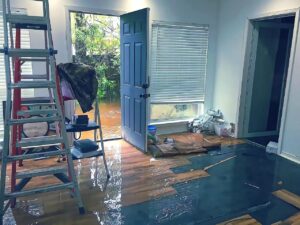Not all forms of severe water damage come from storms or floods occurring outside of the home. Internal water damage can also be catastrophic, causing widespread damage before you even know something is wrong. Internal sources of water damage are far more common than flooding or storms. Don’t let a leaking pipe or clogged toilet lead to long-term damage to your home or business. Learn about the many causes of catastrophic water damage and how to deal with restoration the right way with help from our team at Emrick Environmental Services.
What Forms of Water Damage Are Common in a Home?
Since your home is full of appliances relying on constant water connections, there are potentially a dozen or more spots that could lead to water damage. Practically, anywhere water lines are run to an appliance or fixture, there is the possibility of a long-term or major leak. Even small lines like those that connect to a refrigerator’s ice maker or the washing machine can become damaged and lead to serious water damage. An ice maker flood may be the last thing on your mind, but this appliance can cause a surprising amount of damage if the refrigerator obscures the drips and puddles. Bathrooms are common sources of water damage inside a home—and not just the tub or shower fixtures. A toilet flood can occur any time the toilet is clogged, or there’s a malfunction with the tank. Other appliances that commonly cause home water damage include:
- Water heaters
- Water softeners and filtration units
- Garbage disposals that aren’t connected properly
- Leaking faucets
- Home bar fixtures
- Hot tubs and jacuzzi tubs
- Bidet
- Dishwashers
Signs of Water Damage From Internal Sources
It’s easy to notice storm or flood damage has occurred because the water accumulates in large quantities, and there are obvious signs of damage. Internal sources of water damage can be much more subtle in how they affect the home, especially if the leak starts out small. Instead of expecting to find a foot of water filling every room of the home, look for discoloration and dampness around the fixtures listed above. Musty or moldy odors indicate issues as well, especially if you can’t find any surface mold that would explain the smell. If possible, use the crawlspace or basement of your home to check water connections from below.
The Dangers of Category 2 and 3 Water Damage
Water damage is rated by the severity of the water released, not how much of it affects the home. Category 1 water leaks only involve water lines that carry fresh drinking water, such as supply lines for an ice machine. These leaks can still be catastrophic, but they’re less likely to cause an immediate health concern. Category 2 is greywater, which includes water from showers and washing machines. It’s more likely to cause mold and bacterial problems, but it’s not as dangerous as category 3 water damage, which comes from sewage leaks and black water. Due to its high levels of bacteria and risks of virus transmission, category 3 water damage is the most dangerous to your health. All water damage needs prompt cleanup, but any Category 2 or 3 leaks should be treated as emergencies. Avoid leak or flood areas until restoration is complete for the safety of the entire family. Here at Emrick Environmental Services, we can handle all three types of internal water damage without hesitation or issue.
How a Small Leak Can Become Catastrophic
While it may seem impossible for a small water line connected to a dishwasher or ice maker to cause catastrophic damage, these leaks often go unnoticed for months or even years, causing widespread damage. Once moisture becomes a constant problem under an appliance or inside of a wall, rot quickly sets in and threatens the stability of the entire structure. Mold can spread far and wide, ruining indoor air quality and leaving stains that are hard to cover without professional remediation and repairs.
Each water restoration process starts with a thorough inspection to determine how far the damage has spread. But it’s not enough to just remove all the moisture and call the problem solved. If the water damage has lingered long enough, you’ll need to remove the damaged material and rebuild. Our team here at Emrick can easily handle all three steps, so you can go from the discovery of damage to a safe and beautiful home again in a hurry. Contact us today to schedule an inspection or discuss your questions about catastrophic water damage restoration.








